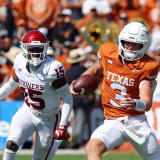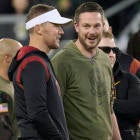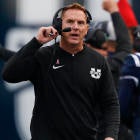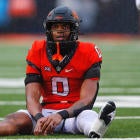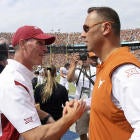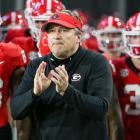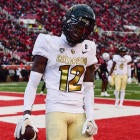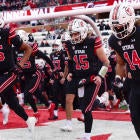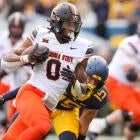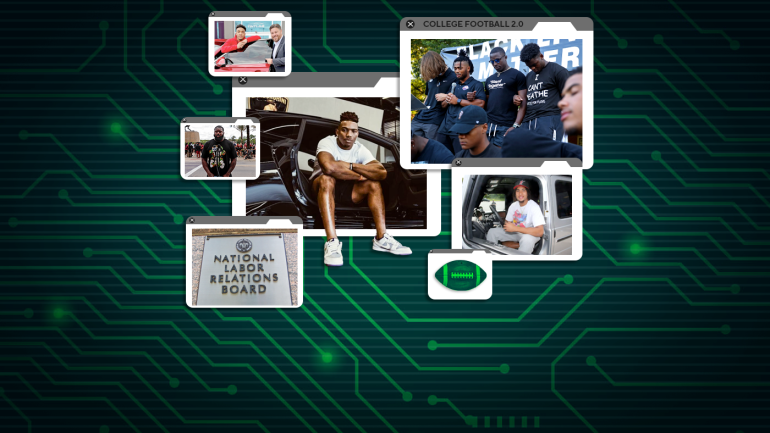
On June 1, 2020, a few months after the start of the COVID-19 pandemic, college football players became among the first groups to return to work.
Programs fretted about lost revenue from television rights and ticket sales devastating their bottom lines. At the same time, racial justice protests swept the country in the wake of George Floyd's murder.
That unique moment in history created a perfect storm that, in hindsight, added fuel to athletes becoming active and vocal constituents in determining what's to become of college sports.
This week, CBS Sports recognizes the first anniversary of name, image and likeness rights being granted to athletes as the jumping off point for a three-part series taking a more intensive look at the state of college football and future of the game.
Part I: Leadership void must be filled to address sport's uncertain, unregulated future
"I think the last two years have been pretty pivotal," said Ramogi Huma, executive director of the National College Players Association. "I think it's made clear how critical college football players are to this industry, that it's big business."
Huma started the NCPA in the 1990s after watching injustices spring up during his time playing at UCLA. One teammate received a full-game suspended after receiving money for groceries from an agent. Another struggled to pay healthcare bills after suffering an injury in a voluntary summer practice. (NCAA legislation at the time prevented schools from contributing to such medical bills.)
Progress toward increased rights for athletes has since begun moving much quicker since U.S. Supreme Court ruled in the landmark NCAA v. Alston case last June that restrictions on name, image and likeness legislation violated antitrust law. In the year since NIL went into effect, college athletes have not only capitalized monetarily but gained an increased understanding of the value that had long been kept from them.
"It happened so fast and there was such a push for it," Stanford wide receiver Elijah Higgins said. "Players began to understand their rights. Players began to understand how much money was actually on the table. Players started to understand how wrong it was for them to not be able to use their own name, image and likeness to benefit themselves."
Cracking the door
The arrival of NIL has opened the floodgates with players seeking to address several issues, including with still-young transfer portal and even younger one-time transfer exemption that have created more flexibility and movement for players.
However, NIL -- along with mysterious booster-run collectives that have suddenly taken up much of the air around the sport -- only brings further questions about the long-term relationship between players and their schools.
"We could evolve into a system where they are giving more voice and opportunity to their athletes," leading antitrust attorney Jeffrey Kessler said. "There is a bill pending in Congress which would allow athletes to unionize with state schools. Otherwise, the problem is the schools with the biggest revenue are mostly state schools. Right now, they can't be denied. That's a real barrier."
Kessler's comments come nine months after National Labor Relations Board general counsel Jennifer Abruzzo wrote in a memo that revenue-producing athletes at private schools should be considered employees, which would allow them to unionize. The memo is a non-binding decision only impacting the 18 private institutions in the FBS, but it does signal a friendlier NLRB response should a team try to unionize as Northwestern players attempted in 2015.
"It definitely opens the door for college athletes to attempt collective bargaining," said player advocate attorney Tim Nevius. "This helps lay out a roadmap for action by athletes to be recognized as employees and perhaps form a union."
The NCAA refuted the NLRB's findings, claiming that athletes are amateur students who participate in a glorified extracurricular educational experience. However, over the next five years, this question will almost assuredly be put to the test. If responses to those are the same as the results of nearly every NCAA court case over the past decade, players have a real shot at winning.
"[Employment] doesn't change the nature of what players are to universities," Huma said. "It finally validates the nature."
Athletes could benefit massively from becoming employees as that status comes with numerous legal protections. It would clear the way for players to form unions and collectively bargain. That could lead to revenue sharing, along with overtime pay and regulations covering their health and safety.
Leading officials across the sport are reluctant to buy into the concept of athletes being defined as employees. Pac-12 commissioner George Kliavkoff called the idea an "existential threat to college athletics" in comments to CBS Sports.
"If you create an employment structure, the other kids on the teams are going to lose their degrees. They're going to lose freedom where they want to play," Kliavokoff said. "By definition, we're going to have a draft system: They can be traded or fired."
While Kliavkoff's stance has merit, running off scholarship players is already common practice for major programs. In his own conference, USC coach Lincoln Riley has notably utilized a little-known rule to cut 10 scholarship players from his 85-man counter, according to The Athletic.
Conversely, players being contracted as employees could create advantages in the realms of player movement and compensatory benefits. Schools could offer guaranteed contracts with buyouts or option deals. They could also require athletes to stay in college for a set period. These are all common features of professional sports contracts.
Of course, unintended consequences are sure to pop up as massive public educational institutions must start asking complicated questions about compensation.
"There are certainly things that have cried out for flexibility for a while," said Bob Bowlsby, outgoing Big 12 commissioner, "but we shouldn't be thinking about creating yet another layer of professional sports because I don't think that's what higher education is about. I think there would be a fair amount of higher education that would repel that idea."
How do players get there?
Whether it comes from unions, employment status or national legislation around college athletes -- like the College Athlete Bill of Rights proposed by Sens. Cory Booker (D-NJ) and Richard Blumenthal (D-CT) in December 2020 -- change is coming fast.
"There's never been a more important point," Huma said. "This is a time when lawmakers are listening, the media is listening, federal agencies are listening, lawyers are active. Ten years ago, it wasn't quite like this. Ten years ago, many people would have stood on the NCAA's side.
"Now, the NCAA is pretty much isolated."
NIL and player compensation remains a distant secondary issue to Huma behind further protections for health and safety. He sees the coming years as a critical time for athletes as competition grows. Ultimately, achieving a collective voice or Congressional action to lean upon would make it much easier for players to get their say.
College programs can try and get ahead of player demands by being proactive. Increased player involvement is almost a certainty.
UCLA athletic director Martin Jarmond foresees players organizing for group licensing opportunities within 2-3 years.
"I think that's on the table," said Jarmond regarding the prospect of revenue sharing with players. "I think that's possible."
Jarmond has looked into the prospect of involving athletes in marketing campaigns. For example, he suggested promoting an autograph opportunity with a star such as Jaime Jaquez Jr. at a game that would not otherwise be well attended.
"I think it's got to be more of a partnership," Jarmond said.
That timeline could be accelerated if EA Sports restarts its "NCAA Football" video game franchise in 2023, as has been previously reported. Players will almost certainly share in revenue from that game for the use of their names, images and likenesses.
"NCAA Football" was discontinued in 2014 because NCAA rules didn't allow revenue sharing. Making common sense reforms and opening the door to group licensing opportunities -- and perhaps even collective bargaining -- could appease athletes.
"The more fair and equitable the treatment of the athletes, the less pressure there is to push for more," said Gabe Feldman, professor of sports law at Tulane. "The need for a union decreases as athletes are given [more rights]."
What's next?
One complication for college football players -- compared to other professional athletes – is the transient nature of their workforce. Players only have up to five years eligibility with many departing after just three years.
It's unusual for players to have more than 1-2 years of maximum value as leaders on and off the field, whereas an NBA star Phoenix Suns point guard Chris Paul spent eight years as president of the National Basketball Players Association.
The NCPA and other like-minded organizations have set out long-term goals in hopes of furthering players' rights long term. Those around the NIL space also take issue with the characterization that players are solely motivated by short-term financial gains.
"People have the wrong impression," said Miami mega-booster John Ruiz, who has signed more than 100 athletes to NIL deals across South Florida. "These kids and their families are not just looking for a payday. They're looking for education, for stability, for knowledge, for networking. They're looking for a place where they can play for 2-3 years and have the best opportunity heading forward."
As college football consolidates and TV revenue explodes, making the case that football programs that generate $100 million a year are amateur operations becomes more tenuous.
The NCAA is working overtime to try and weigh the consequences of this new world as it continues to rebuild its constitution through the NCAA Division I Transformation Committee.
If the NCAA fails to respond fleetly enough, the enterprise may find itself changed from the outside in.
"The people who are benefitting off of [the system] aren't going to find a reason to change," said Higgins, an All-Pac 12 pass catcher. "Obviously, it will need to be a push from the people who are affected, the people who care about the issue or people who understand the issue -- and want to fix it."


